|
Ancient Jewelry
|
|
 |
|
 |
|

Price :
$4600.00
This genuine Ancient Egyptian scarab amulet has been mounted in a modern 18 Karat gold ring.
By far the most important amulet in ancient Egypt was the scarab, symbolically More »
This genuine Ancient Egyptian scarab amulet has been mounted in a modern 18 Karat gold ring.
By far the most important amulet in ancient Egypt was the scarab, symbolically as sacred to the Egyptians as the cross is to Christians. Based upon the dung beetle, this sacred creature forms a ball of dung around its semen and rolls it in a large ball over the sand dropping it into its burrow. The female lays her eggs on the ground and covers them with the excrement ball that is consumed by the larvae that emerge in the following days as if miraculously reborn. In the life cycle of the beetle, the Ancient Egyptians envisioned a microcosm of the daily rebirth of the sun. They imagined the ancient sun god Khepri was a great scarab beetle rolling the sun across the heavens. The scarab also became a symbol of the enduring human soul as well, hence its frequent appearance in funerary art. Scarabs of various materials form an important class of Egyptian antiquities. Though they first appeared in the late Old Kingdom (roughly 2575–2130 B.C.), scarabs remained rare until Middle Kingdom times (circa 1938-1600 B.C.) when they were fashioned in great numbers. While some were used as ornaments, others were purely amuletic in purpose. - (FJ.5103) « Less
|
|
Ancient Jewelry
|
|
|
|
|
| Vendor Details |
Close |
| Contact Info : |
| Barakat Gallery |
| 405 North Rodeo Drive |
| Beverly Hills |
| California-90210 |
| USA |
| Email : barakat@barakatgallery.com |
| Phone : 310.859.8408 |
|
|
|
|
|
|
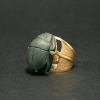
Price :
$4600.00
By far the most important amulet in ancient Egypt was the scarab, symbolically as sacred to the Egyptians as the cross is to Christians. Based upon the dung beetle, this More »
By far the most important amulet in ancient Egypt was the scarab, symbolically as sacred to the Egyptians as the cross is to Christians. Based upon the dung beetle, this sacred creature forms a ball of dung around its semen and rolls it in a large ball over the sand dropping it into its burrow. The female lays her eggs on the ground and covers them with the excrement ball that is consumed by the larvae that emerge in the following days as if miraculously reborn. In the life cycle of the beetle, the Ancient Egyptians envisioned a microcosm of the daily rebirth of the sun. They imagined the ancient sun god Khepri was a great scarab beetle rolling the sun across the heavens. The scarab also became a symbol of the enduring human soul as well, hence its frequent appearance in funerary art. Scarabs of various materials form an important class of Egyptian antiquities. Though they first appeared in the late Old Kingdom (roughly 2575–2130 B.C.), scarabs remained rare until Middle Kingdom times (circa 1938-1600 B.C.) when they were fashioned in great numbers. While some were used as ornaments, others were purely amuletic in purpose. - (FJ.0959) « Less
|
|
Ancient Jewelry
|
|
|
|
|
| Vendor Details |
Close |
| Contact Info : |
| Barakat Gallery |
| 405 North Rodeo Drive |
| Beverly Hills |
| California-90210 |
| USA |
| Email : barakat@barakatgallery.com |
| Phone : 310.859.8408 |
|
|
|
|
|
|
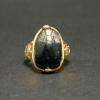
Price :
$4200.00
By far the most important amulet in ancient Egypt was the scarab, symbolically as sacred to the Egyptians as the cross is to Christians. Based upon the dung beetle, this More »
By far the most important amulet in ancient Egypt was the scarab, symbolically as sacred to the Egyptians as the cross is to Christians. Based upon the dung beetle, this sacred creature forms a ball of dung around its semen and rolls it in a large ball over the sand dropping it into its burrow. The female lays her eggs on the ground and covers them with the excrement ball that is consumed by the larvae that emerge in the following days as if miraculously reborn. In the life cycle of the beetle, the Ancient Egyptians envisioned a microcosm of the daily rebirth of the sun. They imagined the ancient sun god Khepri was a great scarab beetle rolling the sun across the heavens. The scarab also became a symbol of the enduring human soul as well, hence its frequent appearance in funerary art. Scarabs of various materials form an important class of Egyptian antiquities. Though they first appeared in the late Old Kingdom (roughly 2575–2130 B.C.), scarabs remained rare until Middle Kingdom times (circa 1938-1600 B.C.) when they were fashioned in great numbers. While some were used as ornaments, others were purely amuletic in purpose. - (MT.118) « Less
|
|
Ancient Jewelry
|
|
|
|
|
| Vendor Details |
Close |
| Contact Info : |
| Barakat Gallery |
| 405 North Rodeo Drive |
| Beverly Hills |
| California-90210 |
| USA |
| Email : barakat@barakatgallery.com |
| Phone : 310.859.8408 |
|
|
|
|
|
|
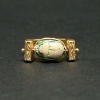
Price :
$9000.00
By far the most important amulet in ancient Egypt was the scarab, symbolically as sacred to the Egyptians as the cross is to Christians. Based upon the dung beetle, this More »
By far the most important amulet in ancient Egypt was the scarab, symbolically as sacred to the Egyptians as the cross is to Christians. Based upon the dung beetle, this sacred creature forms a ball of dung around its semen and rolls it in a large ball over the sand dropping it into its burrow. The female lays her eggs on the ground and covers them with the excrement ball that is consumed by the larvae that emerge in the following days as if miraculously reborn. In the life cycle of the beetle, the Ancient Egyptians envisioned a microcosm of the daily rebirth of the sun. They imagined the ancient sun god Khepri was a great scarab beetle rolling the sun across the heavens. The scarab also became a symbol of the enduring human soul as well, hence its frequent appearance in funerary art. Scarabs of various materials form an important class of Egyptian antiquities. Though they first appeared in the late Old Kingdom (roughly 2575–2130 B.C.), scarabs remained rare until Middle Kingdom times (circa 1938-1600 B.C.) when they were fashioned in great numbers. While some were used as ornaments, others were purely amuletic in purpose - (DAC.081) « Less
|
|
Ancient Jewelry
|
|
|
|
|
| Vendor Details |
Close |
| Contact Info : |
| Barakat Gallery |
| 405 North Rodeo Drive |
| Beverly Hills |
| California-90210 |
| USA |
| Email : barakat@barakatgallery.com |
| Phone : 310.859.8408 |
|
|
|
|
|
|

Price :
$3600.00
The sacred beetle of ancient Egypt, the scarab is an emblem of the creator, Khepera. The word kepher denotes Being, Existence, Creation, or Becoming, and the god Kephera is More »
The sacred beetle of ancient Egypt, the scarab is an emblem of the creator, Khepera. The word kepher denotes Being, Existence, Creation, or Becoming, and the god Kephera is the self-existent maker of all things. The worship of the scarab, which is symbolic of resurrection and fertility, dates from the earliest period of civilization in Egypt. Carved scarabs served two major functions: as amulets with protective and religious powers, and as personal seals, which designated the property and authority of the individual whose name was placed upon them. In both cases, the power ascribed to the scarab was very great—in life they served as the signature of their owner and were thought to bring prosperity, and in the afterlife they ensured rebirth through eternity. - (CK.0579) « Less
|
|
Ancient Jewelry
|
|
|
|
|
| Vendor Details |
Close |
| Contact Info : |
| Barakat Gallery |
| 405 North Rodeo Drive |
| Beverly Hills |
| California-90210 |
| USA |
| Email : barakat@barakatgallery.com |
| Phone : 310.859.8408 |
|
|
|
|
|
|

Price :
$360.00
Of all the technological achievements of civilization, perhaps none so delights the senses as glass. For thousands of years, glass has been used to create jewelry, works of More »
Of all the technological achievements of civilization, perhaps none so delights the senses as glass. For thousands of years, glass has been used to create jewelry, works of art, and functional objects of great beauty. In the bible, the value of glass is equated with that of gold and silver, and it was indeed treated by the ancients as a precious substance. The origins of glass are lost in the mists of time, but the Egyptians in the 4th millennium B.C most probably invented it. The roman naturalist Pliny attributes the discovery of glassmaking to the Phoenicians, and the cities of the Levant were famous as centers for the glass trade. The earliest glass was opaque, colored in a variety of rich hues that often imitated gems like lapis and emerald. The Egyptians used it extensively in jewelry and made little distinction between the genuine and the artificial gems. The art of glassblowing and the development of transparent glass both date to the roman period. From centers like Tyre and Alexandria, glass vessels were exported throughout the empire and as Far East as Persia and china. The Romans colored their glass in myriad shades, favoring blue, green and yellow, as well as clear. One of the most fascinating properties of glass is that, through oxidization, it acquires a rich iridescent patina with age. Brilliant as a peacock's tail, this glass jewel is a piece of history that appeals directly to the contemporary eye. - (FJ.3766) « Less
|
|
Ancient Jewelry
|
|
|
|
|
| Vendor Details |
Close |
| Contact Info : |
| Barakat Gallery |
| 405 North Rodeo Drive |
| Beverly Hills |
| California-90210 |
| USA |
| Email : barakat@barakatgallery.com |
| Phone : 310.859.8408 |
|
|
|
|
|
|
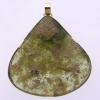
Price :
Contact Dealer
Origin: The Holy Land Circa: 100 AD to 300 AD Collection: Roman Glass Pendants Medium: glass/gold
Origin: The Holy Land Circa: 100 AD to 300 AD Collection: Roman Glass Pendants Medium: glass/gold « Less
|
|
Ancient Jewelry
|
|
|
|
|
| Vendor Details |
Close |
| Contact Info : |
| Barakat Gallery |
| 405 North Rodeo Drive |
| Beverly Hills |
| California-90210 |
| USA |
| Email : barakat@barakatgallery.com |
| Phone : 310.859.8408 |
|
|
|
|
|
|

Price :
$1200.00
Of all the technological achievements of civilization, perhaps none so delights the senses as glass. For thousands of years, glass has been used to create jewelry, works of More »
Of all the technological achievements of civilization, perhaps none so delights the senses as glass. For thousands of years, glass has been used to create jewelry, works of art, and functional objects of great beauty. In the Bible, the value of glass is equated with that of gold and silver, and it was indeed treated by the ancients as a precious substance. The origins of glass are lost in the mists of time, but it most probably was invented by the Egyptians in the 4th millennium B.C. The Roman naturalist Pliny attributes the discovery of glassmaking to the Phoenicians, and the cities of the Levant were famous as centers for the glass trade. The earliest glass was opaque, colored in a variety of rich hues that often imitated gems like lapis and emerald. The Egyptians used it extensively in jewelry and made little distinction between the genuine and the artificial gems. The art of glassblowing and the development of transparent glass both date to the Roman period. From centers like Tyre and Alexandria, glass vessels were exported throughout the empire and as far east as Persia and China. The Romans colored their glass in myriad shades, favoring blue, green and yellow, as well as clear. One of the most fascinating properties of glass is that, through oxidization, it acquires a rich iridescent patina with age. Brilliant as a peacock's tail, this glass jewel is a piece of history that appeals directly to the contemporary eye. - (FJ.4483) « Less
|
|
Ancient Jewelry
|
|
|
|
|
| Vendor Details |
Close |
| Contact Info : |
| Barakat Gallery |
| 405 North Rodeo Drive |
| Beverly Hills |
| California-90210 |
| USA |
| Email : barakat@barakatgallery.com |
| Phone : 310.859.8408 |
|
|
|
|
|
|
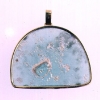
Price :
$1200.00
Of all the technological achievements of civilization, perhaps none so delights the senses as glass. For thousands of years, glass has been used to create jewelry, works of More »
Of all the technological achievements of civilization, perhaps none so delights the senses as glass. For thousands of years, glass has been used to create jewelry, works of art, and functional objects of great beauty. In the Bible, the value of glass is equated with that of gold and silver, and it was indeed treated by the ancients as a precious substance. The origins of glass are lost in the mists of time, but it most probably was invented by the Egyptians in the 4th millennium B.C. The Roman naturalist Pliny attributes the discovery of glassmaking to the Phoenicians, and the cities of the Levant were famous as centers for the glass trade. The earliest glass was opaque, colored in a variety of rich hues that often imitated gems like lapis and emerald. The Egyptians used it extensively in jewelry and made little distinction between the genuine and the artificial gems. The art of glassblowing and the development of transparent glass both date to the Roman period. From centers like Tyre and Alexandria, glass vessels were exported throughout the empire and as far east as Persia and China. The Romans colored their glass in myriad shades, favoring blue, green and yellow, as well as clear. One of the most fascinating properties of glass is that, through oxidization, it acquires a rich iridescent patina with age. Brilliant as a peacock's tail, this glass jewel is a piece of history that appeals directly to the contemporary eye. - (FJ.4484) « Less
|
|
Ancient Jewelry
|
|
|
|
|
| Vendor Details |
Close |
| Contact Info : |
| Barakat Gallery |
| 405 North Rodeo Drive |
| Beverly Hills |
| California-90210 |
| USA |
| Email : barakat@barakatgallery.com |
| Phone : 310.859.8408 |
|
|
|
|
|
|

Price :
$1250.00
Of all the technological achievements of civilization, perhaps none so delights the senses as glass. For thousands of years, glass has been used to create jewelry, works of More »
Of all the technological achievements of civilization, perhaps none so delights the senses as glass. For thousands of years, glass has been used to create jewelry, works of art, and functional objects of great beauty. In the Bible, the value of glass is equated with that of gold and silver, and it was indeed treated by the ancients as a precious substance. The origins of glass are lost in the mists of time, but it most probably was invented by the Egyptians in the 4th millennium B.C. The Roman naturalist Pliny attributes the discovery of glassmaking to the Phoenicians, and the cities of the Levant were famous as centers for the glass trade. The earliest glass was opaque, colored in a variety of rich hues that often imitated gems like lapis and emerald. The Egyptians used it extensively in jewelry and made little distinction between the genuine and the artificial gems. The art of glassblowing and the development of transparent glass both date to the Roman period. From centers like Tyre and Alexandria, glass vessels were exported throughout the empire and as far east as Persia and China. The Romans colored their glass in myriad shades, favoring blue, green and yellow, as well as clear. One of the most fascinating properties of glass is that, through oxidization, it acquires a rich iridescent patina with age. Brilliant as a peacock's tail, this glass jewel is a piece of history that appeals directly to the contemporary eye. - (FJ.4485) « Less
|
|
Ancient Jewelry
|
|
|
|
|
| Vendor Details |
Close |
| Contact Info : |
| Barakat Gallery |
| 405 North Rodeo Drive |
| Beverly Hills |
| California-90210 |
| USA |
| Email : barakat@barakatgallery.com |
| Phone : 310.859.8408 |
|
|
|
|
|
|
|
|

|


